BERZELIUS, Jöns Jakob.
(1779 – 1848)
Berzelius studied medicine and chemistry at the University of Uppsala, from which he graduated 1804. In 1806, he was appointed professor of chemistry at the University of Stockholm. He became a prolific researcher and editor. In 1810, Berzelius was elected president of the Academy of Science. He was greatly distinguished by his skill and precision as a chemical analyst (probably the best of his generation), and he contributed much to advance the atomic theory first stated by Dalton by proposing a chemical nomenclature based upon it.
Biographical references: Barr, Index to Biographical Fragments, 1973: 22. • Beekman, Systematische Mineralogie, 1906: 101 & 107. • Berzelius, J.J., Selbstbiographische Aufzeichnungen. Herausgegeben von H. G. Söderbaum. Nach der wörtlichen Übersetzung von Emilie Wöhler bearbeitet von Georg W. A. Kahlbaum. Amedeo Avogadro und die Molekulartheorie. Von Icilio Guareschi. Deutsch von Dr. Otto Merckens. Leipzig, 1903. 8°: xiv, 194 p. [Published as: Monographieen aus der Geschichte der Chemie. Heft 7.; Berzelius' autobiography.]. • Bugge, Buch der grossen Chemiker, 1929: 1, 428-49. • Callisen, Medicinisches Schriftstellar-Lexicon, 1830-45: 2, 199-212 & 26, 274-9. • Catalogue of Portraits of Naturalists: 178 [4 portraits listed]. • Cleevely, World Palæontological Collections, 1983: 56. • Drugulin, Sechstausend Portraits, 1863: nos. 398-407 & 6054. • DSB: 2, 90-7 [by H.M. Leicester]. • Encyclopaedia Britannica, 11th edition. • Fischer, Mineralogie in Sachsen, 1939: 317-8. • Fruton, Bio-Bibliography, 1982: 61 [other refs.]. • Great Chemists: 385-402, portrait. • ISIS, 1913-65: 1, 142-4. • Jaffe, Crucibles: The Great Chemists, 1936: 136-156, portrait. • Jorbes, J.E., Jacob Berzelius. His Life and Work. Los Angeles and Berkely, University of California Press, 1970. • Mayerhöfer, Lexikon der Naturwissenschaften, 1958-75: 1, 436-7. • Melhado, E.M., Jacob Berzelius. The emergence of his chemical system. Madison, University of Wisconsin Press, 1981. [1]-357 p. • Partington, History of Chemistry, 1961-70: 4, 142-77, portrait. • Poggendorff: 1, cols. 172-5. • Sarjeant, Geologists, 1980: 2, 544-7, Suppl. 1 (1985), 1, 289-90 & Suppl. 2 (1996), 1, 437-8. • SBA: Scandinavian Biographical Archive: A-375, 317-378; B-024, 114-129. • Schaedler, Biographisch Handwörterbuch, 1891: 11. • Svenskt Biografiskt Handlexikon: 1, 85-6, portrait. • Svenskt Biografiskt Lexikon: 4, 46-60. • Szabadváry, History of Analytical Chemistry, 1966: 125-39, portrait. • Thomas, Dictionary of Biography, 1884: 346. • WBI. • World Who's Who in Science: 167.
Afhandlingar i Fysik, Kemi och Mineralogi. Utgifne af W. Hisinger och J. Berzelius. (Stockholm, 1806-18).See under: Afhandlingar I Fysik.
Försök, att genom Anvöndandet
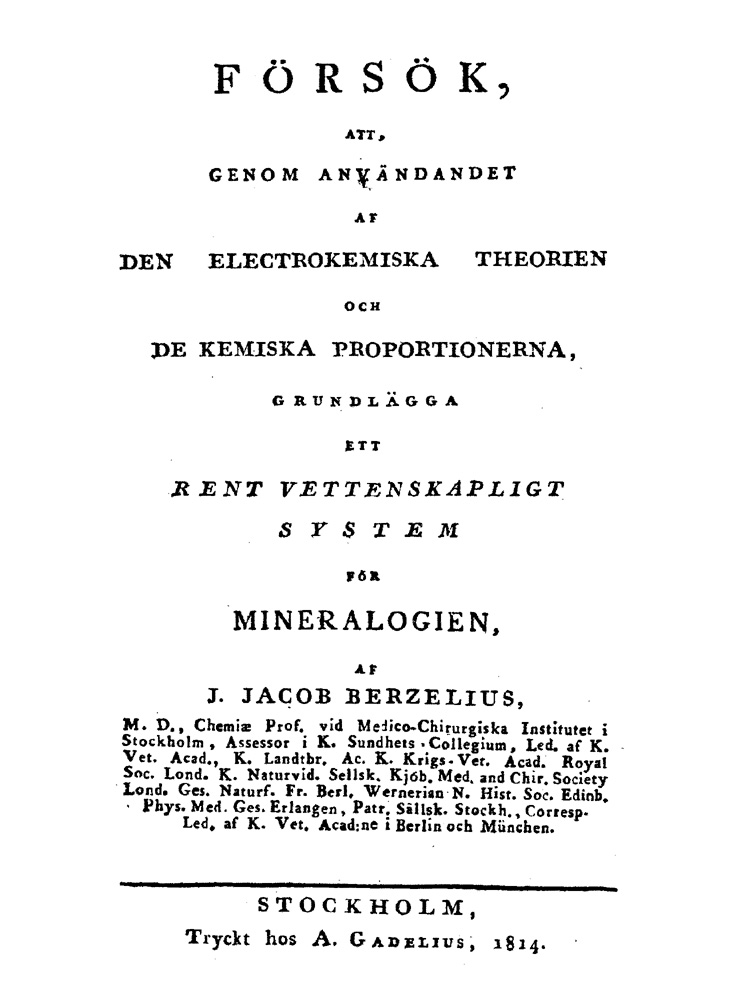
1. Swedish, 1814.
Försök, | att, genom Anvöndandet | af | den Electrokemiska Theorien | och | de Kemiska Proportioerna, | grundlägga | ett | rent vettenskapligt | System | för | Mineralogien, | af | J. Jacob Berzelius, | [...7 lines of titles and memberships...] | [rule] | Stockholm, | Tryckt hos A. Gadelius, 1814.
8°: π1 1-68 73; 52l.; [2], [1]-103 (i.e., 102) p. Page 102 misprinted 103. Page size: 210 x 125 mm. uncut.
Contents: [2 pgs], Title page, verso blank.; [1]-103 (i.e., 102), Text.
Rare. The central premise of Berzelius' chemical theory was the duality of chemical compounds, in which he rigidly classified compounds and their components as either electronegative or electropositive. In the Försök, Berzelius for the first time gives an outline of his theory as it applies to the problem of mineral classification. Because distinguishing the elements of all compounds as either electropositive or electronegative, and giving to every element a place in a series, and a place defined by the degree of these relations, it seemed to provide a rigorous and complete principle of arrangement. Accordingly in the Försök, Berzelius arranged minerals by their electropositive element, and the elements according to their electropositive rank, thus supposedly removing all that was arbitrary and vague in previous chemical classifications of minerals.
Minerals are nothing more than naturally occurring chemical combinations, and in applying his theoretical structure, Berzelius was in the eyes of many contemporaries, attempting to subjugate the science of mineralogy to a branch of chemistry. This caused rather strong arquments to rage in the scientific journals of the period as to the appropiateness of Berzelius' theory. This became especially evident when the discovery of isomorphism showed that bodies containing very different electropositive elements could not be distinguished from each other. It was therefore impractical to place them into different sections of the classification. Thus, this first system of Berzilius crumbled.
Berzelius would not conceed defeat, and after confessing the flaw of his first system, he proceeded to realign his system to be based upon the electronegative element. This inversion of the systemwas an attempt to preserve the duality principle of arrangement. Thus, instead of arranging metallic minerals according to their metal under iron, copper, lead, etc., all carbonate minerals came into one category, while all oxides were classified together in another section. This was a great improvement over the previous effort, and eventually, the correctness of Berzelius' revised method was recognized, and improved upon. To this day, it is one of the cornerstones on which modern mineral classification rests.
German, 1815: A translation in German was published serially in Schweigger's Journal für Chemie und Physik as "Veruch, durch Anwendung der electrisch-chemischen Theorie und der chemischen Proportion-Lehre ein rein wissenschaftlisches System der Mineralogie zu begründen" (see: 11 (1814), 193-233, 12 (1814), 17-62 & 15 (1815), 277-300). The first two installments were translated by A.F. Gehlen and the last by W. Pfaff. The third installment consisted of five appendices that were part of the Swedish original of 1814. Once the publication was completed a very rare Sonderabdruck was made in a small edition and it consists of the first two installments only. It bears the title:
Versuch | durch Anwendung | der | electrisch chemischen | Theorie | und der | chemischen Verhältnisslehre | ein | rein wissenschaftliches | System der Mineralogie | zu begründen | von | J.J. Berzelius. | Aus dem Schwedischen übersetzt | von | A.F. Gehlen. | [rule] | (Einzelner Abdruck dieser im Journal für Chemie und Physik | Bd. XI. u. XII. mitgetheilten Abhandlung.) | [tapered rule] | Nürnberg, | bei Johann Leonhard Schrag. | 1815. 8°: 1-48 57 64; 44 leaves.; [2], [1]-86 p. Leave size: 208 x 116 mm.
Contents: [2 pgs], Title page, verso blank.; [1]-86, Text.
Adolf Ferdinand Gehlen. (Born: Bütow, Pommern, Baltic??, 15 September 1775; Died: Munich, Bavaria, Germany, 15 July 1815) German chemist. Son of an apothecary, Gehlen started out in pharmacetuical studies under Valentin Rose in Berlin. He graduated with a doctorate in chemistry from the University of Halle in 1806. In 1807 he was elected a member of the Academy of Science in Munich.
Bibliographical references: BL [8907.e.22.]. • BL [8907.aa.22.]. • Freilich Sale Catalog: no. 55. • Norman Catalog: no. 225. • Norman Sale Catalog: no. 934. • Partington, History of Chemistry, 1961-70: 4, 142-77. • Whewell, History of the Inductive Sciences, 1858: 2, 347-8. (Gehlen) ADB. • DBA: I 374, 253-261; II 433, 35-37. • Hamberger & Meusel, Gelehrte Teutschland, 1796-1834. • NDB. • Poggendorff: 1, cols. 865-6. • WBI.
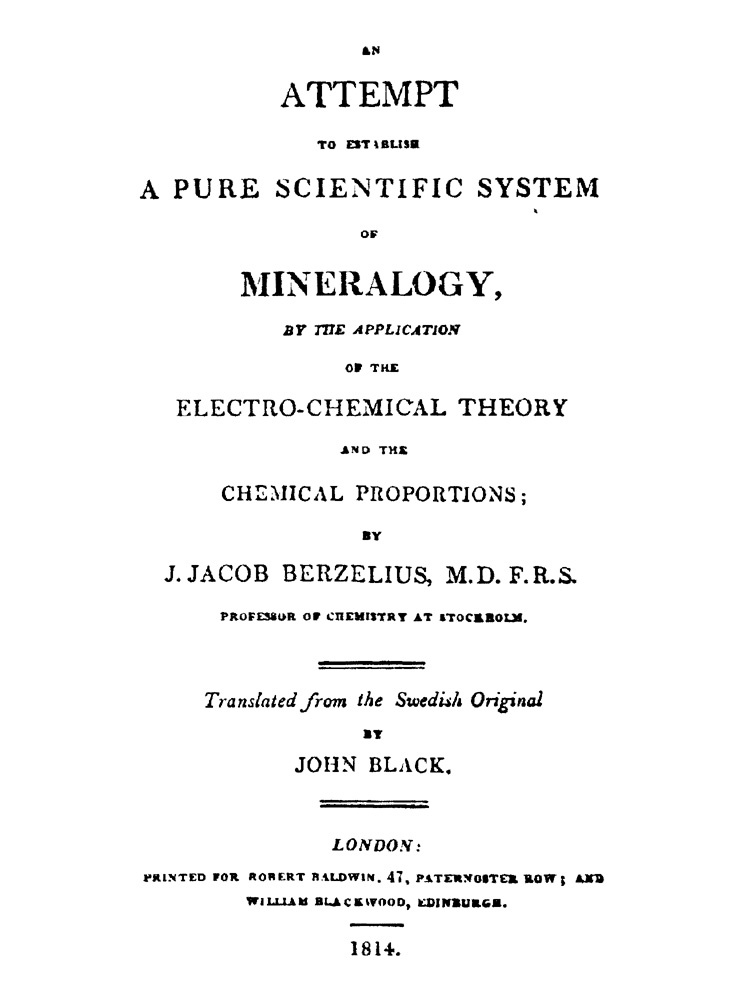
2. English, 1814.
An | Attempt | to Establish | a Pure Scientific System | of | Mineralogy, by application of the Electro-chemical Theory | and the | Chemical Proportions, | By | J. Jacob Berzelius, M.D. F.R.S. | Professor of Chemistry at Stockholm. | [double rule] | Translated from the Swedish Original | by | John Black. | [double rule] | London: | Printed for Robert Baldwin, 47 Paternoster Row; and | William Blackwood, Edinburgh. | [rule] | 1814.
8°: A-I8; 72l.; [1]-144 p. (including 6 pages of advertisements at end). Page size: 190 x 115 mm.
Contents: [1-2], Title page, verso C. Baldwin, Printer ...; [3]-4, "Advertisement."; [5]-108, Text.; [109]-118, "Appendix I."; 119-121, "Appendix II."; 122-124, "Appendix III."; 125-133, "Appendix IV."; [134]-138, "Appendix V."; [139]-144, "Scientific Books Printed for Robert Baldwin and for William Blackwood."
Very scarce. Berzelius sent a copy of the Swedish edition to Thomas Thomson with the request that Thomson have it translated into English, correct the translation and have it published. This thomson did, having engaged the services of one John Black to render the translation. Berzelius was dissatisfied with the quality of the translation remarking in the French edition of 1819 "The English translation... is made unfortunately by someone that has no notion of mineralogy probably, because she/it is full of mistakes; and in many of places original's sense is all to - fact disfigured. She/it appeared cependent preceded of one preface of the doctor Thomson, that assured to have him confronted to the original, and that she/it was perfectly faithful."English translation by John Black from Försök, att, genom anvöndandet af den electrokemiska Theorien (Stockholm, 1814); the whole production supervised by Thomas Thompson, who also wrote the introduction. This is the first appearance in English of calculating the compositions of minerals on the basis of atomic theory, i.e. the law of multipule proportions and also of Berzelius' system of chemical symbols and formulae using the initial letters of the latinised names of the elements, and indicating the proportions of atoms present calculated according to the atomic weights, which has since been established as the standard form of chemical notation.
Owing to the lack of mineral knowledge on the part of the translator Berzelius' work was ill received in England. In fact a reviewer called the work "the most devoted sacrifice to experiment to hypothesis which the modern history of chemistry presents. Berzelius' theory is the measure of his facts, and like the Grecian robber who extended his victims upon his bed, and cut them shorter, if they were too long, or stretched them, if too short, this chemical Procrustes screws his results to the preconceived limits of an empirical axiom."
John Black. (Born: ; Died: ) English translator. Need Biography.
Bibliographical references: BL [987.i.33.]. • BMC: 1, 155. • Cole, Chemical Literature, 1988: no. 135. Ward & Carozzi (1984): no. 201. • Journal of Science and the Arts: 1 (1817), 226-41. • Roller & Goodman, Catalogue, 1976: 1, 112. (Black)
Mineralsystem
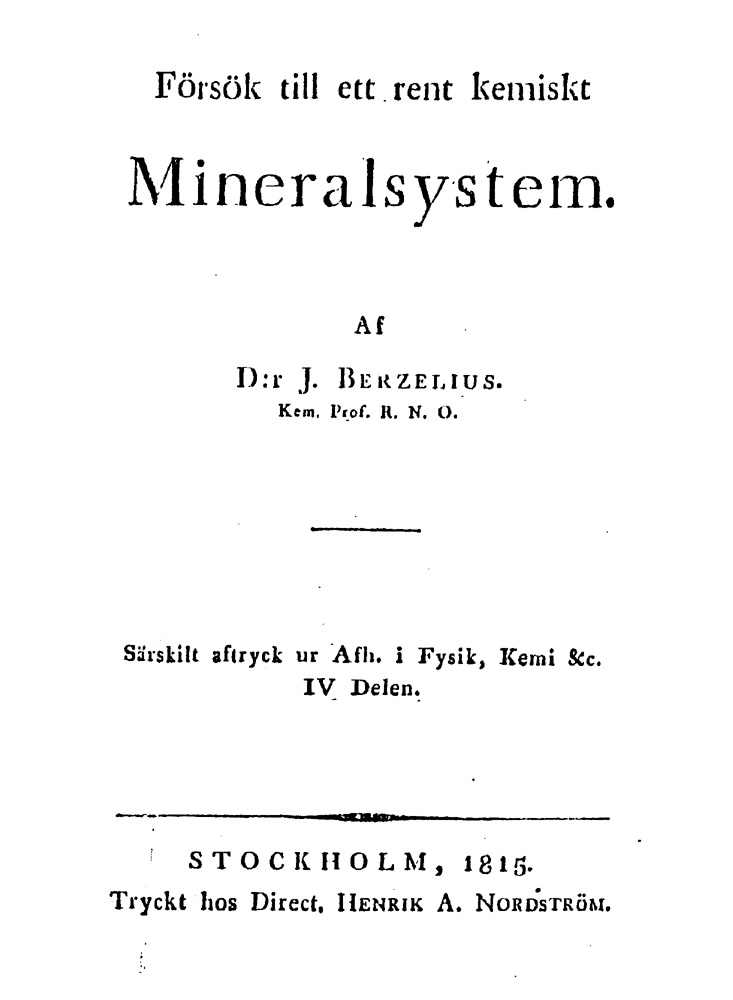
3. Swedish, 1815.
Försök till ett rent kemiskt | Mineralsystem. | Af | D:r J. Berzelius. | Kem. Prof. R.N.O. | [rule] | Särskilt aftryck ur Afh. i Fysik, Kemi &c. | IV Delen. | [tapered rule] | Stockholm, 1815. | Tryckt hos Direct. Henrik A. Nordström.
8°: π1 A-I8 K2; 75l.; [2], [1]-148 p. Page size: 190 x 115 mm.
Contents: [2 pgs], Title page, verso blank. [1]-148, Text.
Rare. After the publication of the original Försök in 1814, the noted mineralogist J.F.L. Hausmann wrote a highly critical review of the work. This provoked Berzelius to publish the Försök till ett rent kemiskt Mineralsystem in 1815. With the addition of this supplemenentary monograph Berzelius' mineralogy no longer looked like an "attempt" but a fully developed mineralogy.This is the separately printed expansion of Berzelius' mineral classification system, based upon the electropositive element. Whereas the Försök published in 1814 was a mere outline, the present title expands the theory to a full mineralogical classification. The work was originally published in Afhandlingar i Fysik, Kemi och Mineralogi (see: 4 (1815), 1-148).
German, 1816: After its original appearance, Berzelius' chemical mineral system was soon thereafter translated into German by W. Pfaff and C. Gmelin and published as the article, "Versuch eines rein chemischen Mineralsystems" in Schweigger's Journal (see: 15 (1815), 301-63 & 419-51 & 22 (1818), 274-302). A last installment, containg the notes to the systematic arrangement of the minerals as they appeared in the original Swedish (pp. 117-148), was published in Schweigger's Journal, under the title, "Anmerkungen zu der Abhandlung: Versuch eines rein chemischen Mineralsystems." Aside from these notes, the monograph contains four parts: the first (pp. 301-23) offered direct responses to Hausmann's criticisms, the second (pp. 323-36) presented further articulations of the chemical and mineralogical concepts, the third (pp. 337-63) contained a critical discussion of previous mineral classifications, and the fourth (pp. 419-51) presented the full mineral system. The separate German edition of the mineralogy was issued as a very rare Sonderabdruck of the 1815 translations by Gmelin and Pfaff. It contained the notes which appeared in it before they were published in Schweigger's Journal. It bears the title:
Neues | System der Mineralogie | von | J.J. Berzelius. | Aus dem Schwedischen übersetzt | von | Dr. Chr. Gmelin und Prof. W. Pfaff. | [ornate rule] | [rule] | Einzelner Abdruck dieser im Journal für Chemie und Physik | Bd. XV. Mitgetheilten Abhandlung. | [tapered rule] | Nürnberg, 1816. | bei Johann Leonhard Schrag. π1 1-88 97 103; 76 leaves.; [2], [1]-148, [2] p. Leave size: 216 x 108 mm.
[2 pgs], Title page, verso blank.; [1]-148, Text.; [2 pgs], "Verbesserungen."
Rare. Pfaff provides a translation of Berzelius' electrochemical theory, while Gmelin gives a detailed examination of Berzelius' chemical mineral system.
Christian Gottlob Gmelin. (Born: Tübingen, Germany, 12 October 1792; Died: ) German physician. Gmelin was a medical doctor, who had taken a long trip throughout France, England, Germany, Norway and Sweden, where he became a student of Berzelius. He was appointed in 1817 a professor of chemistry and pharmacy at the University of Tübingen.
Johann Wilhelm Andreas Pfaff. (Born: Stuttgart, Germany, 5 December 1774; Died: Erlangen, Germany, 26 June 1835) German mathematician. Pfaff was a professor of mathematics at the University of Dorpat (1803-9), then at the Real-Institute in Nuremberg (1809-17), then the Unversity of Würzburg (1817-8) and finally at the University of Erlangen (1819-35).
Bibliographical references: BL [no copy listed]. • BL [no copy listed]. (Gmelin) ADB. • DBA: I 398, 306-307; II 455, 217-219. • Hamberger & Meusel, Gelehrte Teutschland, 1796-1834. • Hirsch, Biographisches Lexikon, 1884-8. • Meusel, Verstorbenen Teutschen Schrifsteller, 1802-16. • Poggendorff: 1, col. 917. • WBI. (Pfaff) ADB. • DBA: I 949, 46-57; II 999, 194-195. • Hamberger & Meusel, Gelehrte Teutschland, 1796-1834. • Meusel, Verstorbenen Teutschen Schrifsteller, 1802-16. • Poggendorff: 2, cols. 428-9. • WBI.
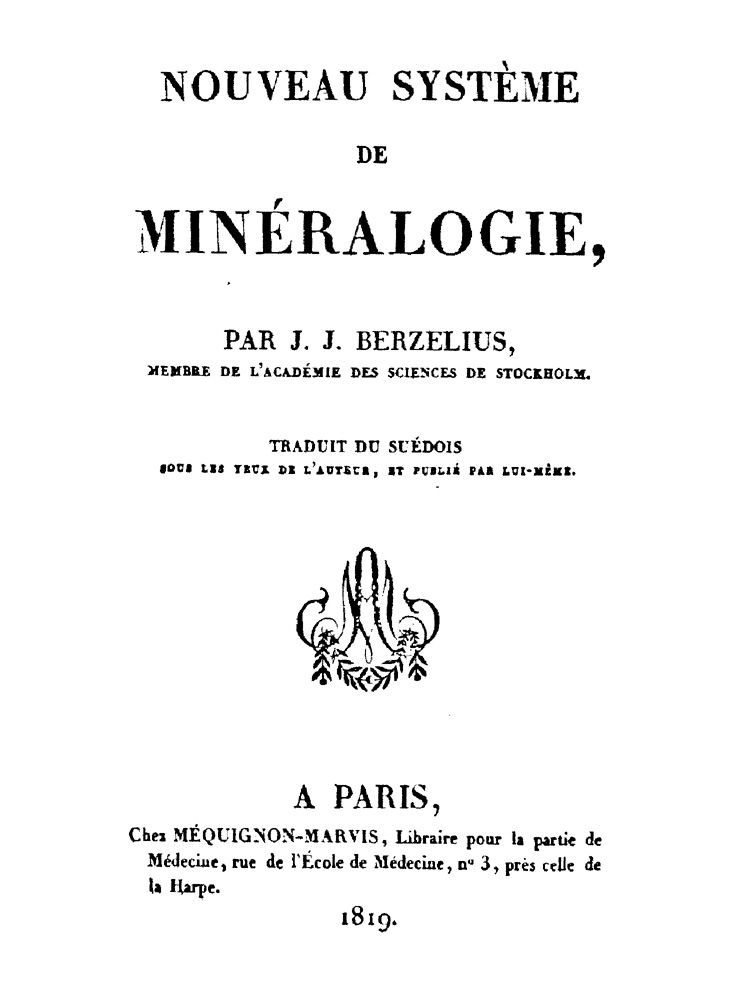
4. French, 1819 [French transl.].
Nouveau Système | de | Minéralogie, | par J.J. Berzelius, | Membre de l'Academie des Sciences de Stockholm. | Traduit du Suédois | sous les yeux de l'Auteur, et Publié par Lui-Même. | [ornament] | A Paris, | Chez Méquignon-Marvis, Libraire pour la partie de | Médecine, rue de l'École de Médecine, no 3, près celle, de | la Harpe. | 1819.
8°: π5 1-198 206; 162l.; [4], [i]-vi, [1]-314, [2] p. Page size: 95 x 120 mm.
Contents: [2 pgs], Half title page, "Nouveau Système | De | Minéralogie," verso blank.; [2 pgs], Title page, verso blank.; [i], Dedication to Réné-Just Haüy.; [ii], Blank.; [iii]-vi, "Introduction."; [1]-106, "Développement | Du Nouveau | Système De Minéralogie."; [107]-149, "Réponse | A quelques objections contre les ideés précé | dentes, accompagnée de quelques réflexions | sur la constitution chimique des minéraux."; [150]-181, "Essai | d'un examen raisonné des principaux sys- | tèmes de minéralogie."; [182]-229, "Arrangement Systematique | Des Minéraux."; 230-310, "Notes."; [311]-314, "Corrigenda."; [1 pg], "Table Des Matières."; [1 pg], Blank.
Scarce. This translation was prepared by André Jean Marie Brochant de Villiers from both the Försök, att, genom anvöndandet af den electrokemiska Theorien (Stockholm, 1814) and the Försök till ett rent kemiskt Mineralsystem (Stockholm, 1815). Brochant alters the text in minor ways, and adds new mineral analyses and many more notes than appeared in the 1815 monograph. It was prepared while Berzelius was visiting Berthollet at Arcueil in 1818-19, and incorporates new information Berzelius supplied to the translator. This was a tremendous improvement over the other translations, and it is the definitive statement of Berzelius' chemical mineralogical classification.
Another translation: A bad translation of Berzelius' theory that appeared in the Journal de Physique (see: 1 (1815), 86).
Bibliographical references: BL [726.g.23.]. • BMC: 1, 155. • Dana's 7th (Bibliography): 66. • Hoover Collection: no. 122. • Roller & Goodman, Catalogue, 1976: 1, 112. • Ward & Carozzi, Geology Emerging, 1984: no. 202.
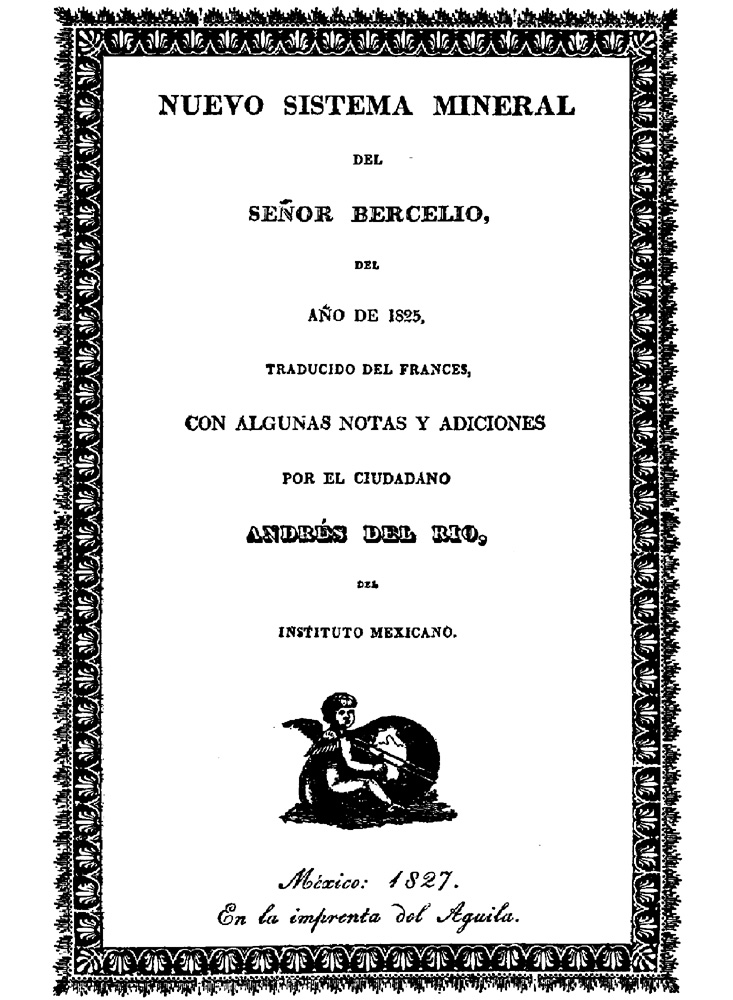
5. Spanish, 1827 [Spanish transl.].
[Contained within an ornate box:] Nuevo Sistema Mineral | Del | Señor Bercelio, | Del | Año De 1825, | Traducido Del Francés, | Con Algunas Notas Y Adiciones | Por El Ciudadano | Andrés Del Rio, | Del | Instituo Mexicano. | [ornament] | México: 1827. | En la imprenta del Aguila.
2°: [2], [1]-28 p.
Very rare. This is a translation and implementation by Andrés del Río of Berzelius' chemical classification of minerals. It was based upon Nouveau Système de Minéralogie (Paris, 1819), and incorporates Del Río's own notes, modifications and additions.
Bibliographical references: BL [7106.d.6.]. • Maffei & Rua Figuera, Bibliografía Mineral, 1871-2: 3, 88-93 [no. 2113]. • NUC: 50, 663-8 [NB 0384285].
Work on Blowpipes
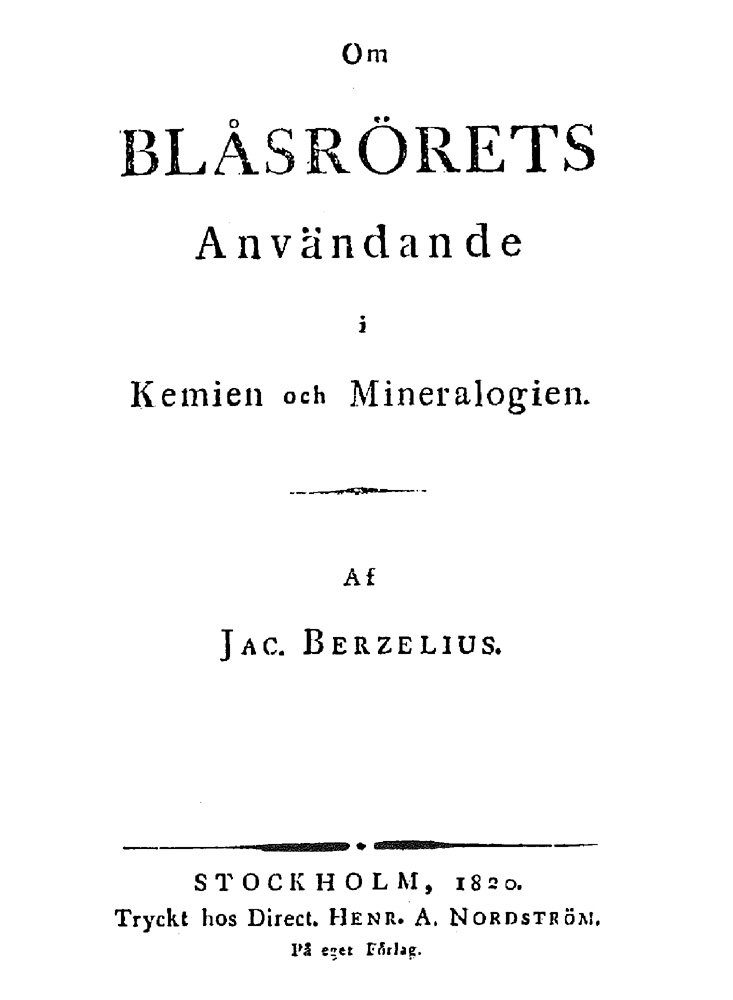
6. Swedish, 1820.
Om | Blåsrörets | Användande | i | Kemien och Mineralogien. | [tapered rule] | Af | Jac. Berzelius. | [ornate rule] | Stockholm, 1820. | Tryckt hos Direct. Henr. A. Nordström. | På eget Förlag.
8°: π5 A-T8; 157l.; [10], [1]-302, [2] p., 4 folding plates (showing 35 figures of blowpipes and apparatus). Page size: 185 x 115 mm.
Contents: [2 pgs], Title page, verso blank.; [1 pg], Dedication to Herrar Ledamöter af Bruks-Societeten.; [1 pg], Blank.; [4 pgs], Preface, not titled.; [2 pgs], "Innehåll."; [1]-296, Text.; 297-302, "Register."; [2 pgs], "Förklaring öfver Tabellerna." [Description of figures on plates].; [At end], 4 folding plates.
Scarce. Berzelius was instructed in the use of the blowpipe by the greatest living practitioner of the period, Johann Gottlieb Gahn. Every summer between 1812 and 1816, Berzelius visited Gahn in Falun. Together they would visit the famous mineral localities of the area, and every new find was subjected to analysis back in Gahn's laboratory. There, Berzelius learned a great deal of the methodology of blowpipe technique. During a journey through England and France in 1819, he had occasion to instruct Parisian mineralogists such as Cordier, Bronigart, Brochant and Beudant in the use of the blowpipe, and before Berzelius left Paris he had promised to write a manual on the use of this important tool.
On his return to Sweden, he kept his promise by authoring the classic book, Om Blåsrörets Användande i Kemien och Mineralogien (Employment of the Blowpipe in Chemistry and Mineralogy). In it, he summarizes all aspects of blowpipe analysis in clear and simple language. Berzelius describes seven different types of blowpipes in detail as well as a special oil lamp of his own design. He distinguishes four zones of the blowpipe flame, and was the first to use the terms "oxidation" and "reduction" in the modern definition. In 1809, Wollaston had successfully isolated platinum, and this enabled Berzelius to describe his use of the metal in making dishes, crucibles and spoons for use in his experiments before the powerful blowpipe flame. He introduces the use of hydrogen fluoride as a reagent, and describes the reactions and reductions of the newer elements.
Johan Gottlieb Gahn. (Born: Ovanåker, Sweden, 19 August 1745; Died: Falun, Sweden, 8 December 1818) Swedish chemist. Gahn was successively consultant (1768), mining master (1782) and assessor (1784) at the Swedish Berg Collegium. He was also involved in the banking industry at Stora Kopparberget. Elected a fellow of the Academy of Sciences in Stockholm in 1784.
Bibliographical references: BL [8906.aa.4.]. • Burchard, History of Blowpipe Analysis, 1984: 255-6. • Cole, Chemical Literature, 1988: no. 136. • Freilich Sale Catalog: no. 56. (Gahn) Biographiskt Lexicon. • Drugulin, Sechstausend Portraits, 1863: no. 1801. • DSB: 5, 222-3. • ISIS, 1913-65: 1, 448. • Poggendorff: 1, cols. 828-9. • SBA: Scandinavian Biographical Archive: B-087, 014-026. • Svenskt Biografiskt Lexikon: 16, 730. • WBI. • World Who's Who in Science: 624.
German editions
7. German, 1821 [First edition].
Jac. Berzelius | von der | Anwendung des Löthrohrs | in der | Chemie und Mineralogie. | [rule] | Aus der Handschrift übersetzt | von Heinr. Rose. | [rule] | Mit IV. Kupfertafeln. | [rule] | Nürnberg, | bei Joh. Leonhard Schrag. | 1821.
8°: π8 1-198 204; 164l.; [i]-xvi, 311, [1] p. [page 256 misnumbered 456], 4 folding plates.
Contents: [i-ii], Title page, verso blank.; [iii]-x, "Vorrede."; xi-xvi, "Inhalt."; xv-xvi, "Erklärung der kupfertafeln."; [1]-301, Text.; 302-308, "Register."; 309-311, "In der Verlagshandlung ist ferner Erschienen."; [1 pg], "Druck-fehler."
Scarce. The first German edition of Om Blåsrörets (Stockholm, 1820), in excellent translation by H. Rose from the author's manuscript. Rose had worked in Berzelius' laboratory, 1818-21, and was clearly familiar with the material documented in the book.
Heinrich Rose. (Born: Berlin, Germany, 6 August 1795; Died: 1864) German chemist. Rose earned his doctorate at the University of Kiel in 1821. Trained as an apothecary, he became a student of Berzelius from 1818-21, after which he was appointed a professor of chemistry at the University of Berlin. In 1833, he was elected a member of the Academy of Science in Berlin. Rose authored numerous chemical papers.
Bibliographical references: BL [no copy listed]. • BMC: 1, 155. • Bolton, Bibliography of Chemistry, 1893: 311. • Cole, Chemical Literature, 1988: no. 138. • Roller & Goodman, Catalogue, 1976: 1, 113. (Rose) ABF: II 562, 154. • ADB. • DBA: I 1054, 140-142; II 1094, 243-253. • Hamberger & Meusel, Gelehrte Teutschland, 1796-1834. • Poggendorff: 2, cols. 687-92 & 3, ??. • WBI.
8. German, 1828 [2nd edition].
Die | Anwendung des Löthrohrs | in der | Chemie und Mineralogie | von J. Jacob Berzelius. | [rule] | Zweite Auflage. | [tapered rule] | Nürnberg, | bei Joh. Leonhard Schrag. | 1828.
8°: *8 χ1 A-R8 S4 T1; 149l.; [i]-xvi, [2], [1]-282 p., 4 folding plates (blowpipes). Page size: 202 x 114 mm. Very scarce.
Contents: [i-ii], Title page, verso blank.; [iii]-vi, "Vorrede," signed Jac. Berzelius, October 1827.; [vii]-xvi, "Inhalt."; [1 pg], Sectional title page, "Erste Abtheilung. | [tapered rule] | Beschreibung des Löthrohrs | und | Anweisung zu Löthrohrversuchen."; [1 pg], Blank.; [1]-115, Text.; [116], Blank.; [117], "Zweite Abtheilung. | [tapered rule] | Verhalten der Mineralien vor | dem Löthrohre."; [118], Blank.; [119]-266, Text.; 267-268, "Anhang."; 269-272, "Von dem Verhalten der Harnsteine vor dem | Löthrohre."; 273, "Berichtigungen."; [274], Blank.; [275]-280, "Register | zur zweiten Abtheilung."; 281-282, "Erklärung der Kupfertafeln."; [At end], 4 folding plates.
Bibliographical references: BL [no copy listed]. • BMC: 1, 155. • Roller & Goodman, Catalogue, 1976: 1, 113.
9. German, 1837 [3rd edition].
Die Anwendung | des | Löthrohrs | in der | Chemie und Mineralogie | von | J. Jacob Berzelius. | [double rule] | Dritte Auflage | mit 4 Kupfertafeln. | [double rule] | Nürnberg, | bei Johann Leonhard Schrag. | 1837.
8°: [i]-xxiv, [1]-320 p., 4 folding plates. Very scarce.
Bibliographical references: BL [726.h.24.]. • Roller & Goodman, Catalogue, 1976: 1, 113.
10. German, 1844 [4th edition].
Die Anwendung | des | Löthrohrs | in der | Chemie und Mineralogie | von | J. Jacob Berzelius. | [rule] | Vierte verbesserte Auflage. | Mit 4 Kupfertafeln. | [tapered rule] | Nürnberg, | Verlag von Johann Leonhard Schrag. | [short rule] | 1844.
8°: [i]-xxiii, [1], [1]-284, [4] p., 4 folding plates. Very scarce.
Contents: [i-ii], Half title page, "Die | Anwendung des Löthrohrs | in der | Chemie und Mineralogie," verso "Druck und Papier | von Friedrich Vieweg und Sohn ..."; [iii-iv], Title page, verso blank.; [v]-ix, "Vorrede."-signed Jac. Berzelius, July 1843.; [x], Blank.; [xi]-xxiii, "Inhalt."; [1 pg], Blank.; [1]-273, Text.; [274], Blank.; [275]-282, "Register."; [283]-284, "Erklärung der Kupfertafeln."; [4 pgs], Publisher's list.; [At end], 4 plates.
Bibliographical references: BL [1143.f.22.]. • BMC: 1, 155. • Roller & Goodman, Catalogue, 1976: 1, 113.
French editions
11. French, 1821 [First edition].
De l'Emploi | du Chalameau | dans les Analyses Chimiques | et | les Déterminations Minéralogiques; | Par M. Berzelius. | Traduit du Suédois par F. Fresnel. | [ornament] | A Paris, | Chez Méquignon-Marvis, Libraire | pour la Partie de Médicine, | rue de l'Ecole de Médecine, No 3. | [rule] | 1821.
8°: π6 1-258; 205l.; [4], [i]-vi, [1]-396, [4] p., 4 folding plates. Page size: 218 x 138 mm.
Contents: [2 pgs], Half title page, "De l'Emploi | du Chalumeau | dans les Analyses Chimiques | et | les Déterminations Minéralogiques," verso advertisement.; [2 pgs], Title page, verso blank.; [i]-vi, "Introduction."; [1]-386, Text.; [387]-394, "Index Minéralogique."; [395]-396, "Table Des Matières."; [2 pgs], "Errata."; [1 pg], Blank.; [1 pg], "Avis."
Very scarce. Excellent first French translation by Fulgence Fresnel of Om Blåsrörets Användande i Kemien och Mineralogien (Stockholm, 1820).
Fulgence Fresnel. (Born: Mathieu (Calvados), France, 1795; Died: Bagdâd, Iraq, 1855) French orientalist & historian. Need Biography.
Bibliographical references: BL [no copy listed]. • Cole, Chemical Literature, 1988: no. 137. • Freilich Sale Catalog: no. 392. • Hoover Collection: no. 123. • Roller & Goodman, Catalogue, 1976: 1, 113. (Fresnel) ABF: I 422, 349-350. • Thomas, Dictionary of Biography, 1884: p. 969. • WBI.
12. French, 1837 [2nd edition].
De L'Emploi | Du Chalumeau | Dans Les Analyses Chimiques | Et | Les Déterminations Minéralogiques; | Par M. Berzélius. | Traduit Du Suédois par F. Fresnel. | [ornate rule] | Paris. | Méquignon-Marvis, Père Et Fils, | Libraires-Éditeurs, | Rue Du Jardinet, No 13. | 1837.
8°: π2 1-248 256; 200l.; [4], [1]-396 p., 4 plates (folding; blowpipes and associated apparatus). Page size: 210 x 126 mm.
Contents: [2 pgs], Half title page, " De L'Emploi | Du Chalumeau | Dans Les Analyses Chimiques | et | Les Déterminations Mineralogiques," verso "Paris-Imprimerie De Terzuolo, | Rue de Vaugiard, No 11."; [2 pgs], Title page, verso blank.; [1]-386, Text.; [387]-394, "Index Minéralogique."; [395]-396, "Table Des Matières.";
Very scarce. Scarce. A history of the blowpipe and instructions on its use occupy pages 1-98, while the remainder of the book describes testing for metals contained in individual specimens.
Bibliographical references: BL [no copy listed]. • Roller & Goodman, Catalogue, 1976: 1, 113.
13. French, 1843 [3rd edition].
De L'Emploi | Du Chalameau | Dans Les Analyses Chimiques | Et | Les Déterminations Minéralogiques. | Par M. Berzelius. | Traduit du Suédois par F. Fresnel. | [ornate rule] | Édité par Méquignon-Marvis père. | Paris, | Librairie Médicale De Médquignon-Marvis, | 3, Rue De L'École De Médecine. | [rule] | 1843. 8°: [4], [1]-396 p., 4 folding plates.
Bibliographical references: BL [no copy listed].
Italian edition
14. Italian, 1822 [Italian transl.].
Analisi Chimica | d'ogni Specie di Minerali | da Eseguirsi Facilmente | colla | cannella dei Saldatori | Opera del Sig. M. Berzelius | tradotta | Prima dallo Svedese in Francese | dal Sig. Fresnel | ora dal Francese in Italiano | dal Prof. Gazzeri. | [rule] | Firenze | dalla Stamperia Piatti | 1822.
8°: π8 2-168 174 182; 134l.; [i]-viii, [1]-258 p.
Contents: [i-ii], Title page, verso blank.; [iii]-iv, "Nota del Traduttore Italiano."; [v]-viii, "Introduzione."; [1]-248, Text.; [249]-250, "Avvertimento del Traduttore Italiano."; [251]-256, "Indice Mineralogico."; 257-258, "Tavola dalle Materie."
Rare. Italian translation by Giuseppe Gazzeri of De l'Emploi du Chalumeau dans les Analyses Chimiques (Paris, 1821), which was reissued in 1823 in Napoli.
Giuseppe Gazzeri. (Born: 1771; Died: 1848) Italian chemist. Need Biography.
Bibliographical references: BL [no copy listed]. (Gazzeri) ABI: I 463, 140-144; II 270, 298. • Codignola, Pedagogisti ed educatori: In: Enciclopedia bio-bibliografica Italiana, 1939. • Provenzal, Bio-Bibliografici di Chimici Italiani, 1938: pp. 99-104. • WBI.
English editions
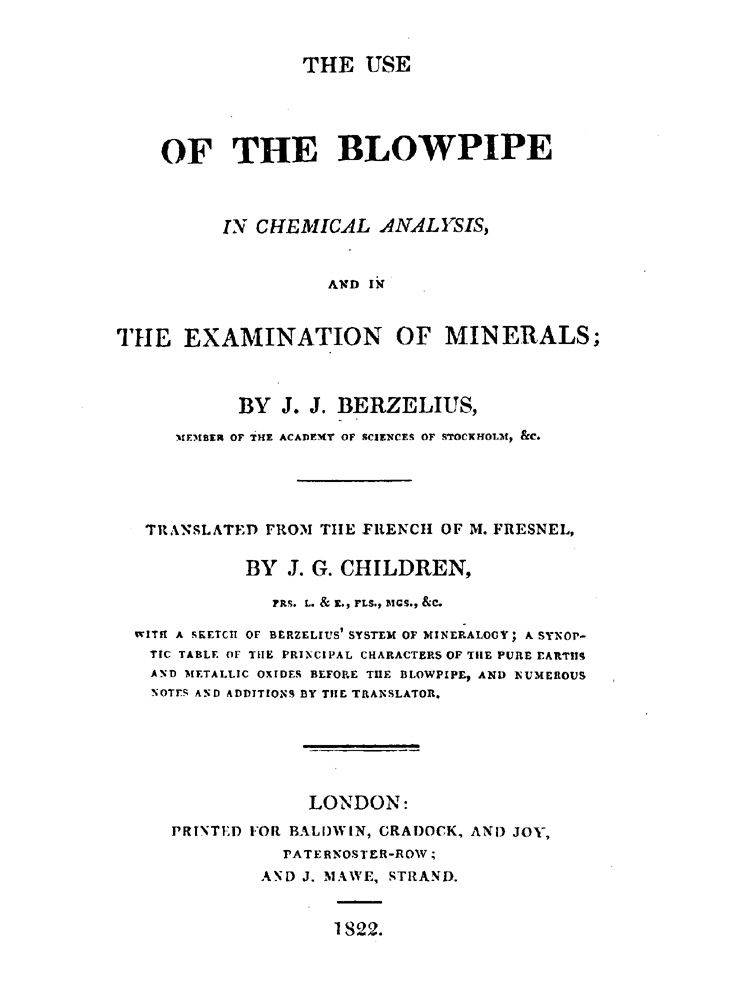
15. English, 1822.
The Use | Of The Blowpipe | in Chemial Analysis, | and in | the Examination of Minerals; | By J.J. Berzelius, | Member of the Academy of Sciences of Stockholm, &c. | [rule] | Translated from the French of M. Fresnel, | by J.G. Childern, | FRS. L. & E., FLS., MGS., &c. | with a sketch of Berzelius' System of Mineralogy; a Synop- | tic Table of the Principal Characters of the Pure Earths | and Metallic Oxides before the Blowpipe, and Numerous | Notes and Additions by the Translator. | [double rule] | London: | Printed for Baldwin, Cradock, and Joy, | Paternoster-row; | and J. Mawe, Strand. | [rule] | 1822.
8°: a-b8 c4 B-Y8 Z4; 192l.; [i]-xxxix, [1], [1]-343, [1] p., 3 plates, one table. Page size: 210 x 128 mm.
Contents: [i-ii], Title page, verso "C. Baldwin, Printer."; [iii], "Dedication to Humphry Davy."; [iv], Blank.; [v]-x, "Translator's Preface"-signed J.G. Childern, March 1822.; [xi]-xv, "Note to the Reader."; [xvi], Blank.; [xvii]-xxxiv, "Sketch of Berzelius's Mineralogical Arrangement, By the Translator."; [xxxv]-xxxix, "Introduction by the Author."; [xxxx], Blank.; [1]-133, Text.; 134-335, "Description of the Phenomena presented by Minerals when exposed to the action of the Blowpipe."; [336], Blank.; [337]-343, "Index."; [1 pg], "Errata.";
Very scarce. First English rendition by J.G. Childern from De l'Emploi du Chalumeau dans les Analyses Chimiques (Paris, 1821). A table facing page 118 is titled, "Synoptic view of the principle characters of the earths and metallic oxides before the blowpipe."
John George Children. (Born: Ferox Hall, Tunbridge, England, 18 May 1777; Died: Halsteadplace, Kent, England, 1 January 1852) English mineralogist & zoologist. Children was educated at Eaton and Cambridge. He was employed as curator of the mineral collection of the British Museum from 1816 until 1840. Elected a Fellow in 1807, he was a longtime secretary of the Royal Society.
Bibliographical references: BL [1035.h.21.]. • Roller & Goodman, Catalogue, 1976: 1, 113. (Children) Annual Register: 1852. • DNB. • Poggendorff: 1, cols. 435-6 & 1550.
16. English, 1845 [American edition].
The Use | of the | Blowpipe | in | Chemistry And Mineralogy. | By J.J. Berzelius. | [rule] | Translated | From The Fourth Enlarged And Corrected Edition, | by J.D. Whitney. | [rule] | Boston: | William D. Ticknor and Co. | M DCCC XLV.
8°: a6 b2 1-196 204 211; 128l.; [i]-xv, [1]-237, [1] p., 4 folding plates. Page size: 215 x 133 mm.
Contents: [i-ii], Title page, verso "Entered according to Act of Congress, in the year 1845, …"; [iii], Translator's preface.; [v]-ix, Introduction, signed J.J. Berzelius, July 1843.; [x], Blank.; [xi]-xv, "Contents."; [1 pg], Blank.; [1]-87, Text, part 1.; [88], Blank.; [89]-220, Text, part 2.; [221]-226, "Supplement."; [227]-230, "Behavior Of Urinary Calculi Before The | Blowpipe."; [231]-237, "Index To Part II."; [1 pg], Blank.; [At end], 4 folding plates.
Scarce. Second English translation and the first published in America by Josiah Dwight Whitney from Die Anwendung des Löthrohrs (4th ed., Nürnberg, 1844). The enormous advances made in blowpiping as a means of determining the compostion of minerals and ores by the celebrated Swedish chemist were deemed of such importance that this translation was perpared by Whitney to serve as an instructional work in the art within the United States school system. Subjects treated include a history of blowpiping, apparatus, equipment, reagents, behavior of elements, and a main text treating specific tests. There is even a supplement for analysis of urinary calculi. The plates depict apparatus.
Josiah Dwight Whitney. (Born: Massachusetts, 1819; Died: 1896) American geologist. Whitney was state geologist for California from 1865 until 1882. In that capacity he made an extensive survey of the land with William H. Brewer, Clarence King, Lorenzo Yates and others. He authored a number of important books, including, Metallic Wealth of the United States (1854), Mountain Heights in the United States (1862), and The Yosemite Book (1868), a beautifully illustrated and rare book. In 1864, he measured the highest peak in the continental United States, which was later named a Mt. Whitney in his honor.
Bibliographical references: BL [1143.f.37.]. • BMC: 1, 156. • Cole, Chemical Literature, 1988: nos. 139 & 140. • Hoover Collection: no. 123. • Roller & Goodman, Catalogue, 1976: 1, 113. (Whitney) ABA: I 1733, 373-388; II 671, 29-30. • Adams, Dictionary of American Authors, 1904. • Appleton Cyclopedia of American Biography. • Drake, Dictionary of American Biography, 1872. • Herringshaw's National Library of American Biography. • National Cyclopedia of American Biography. • WBI.

17. German, 1847.
J.J. Berzelius's | neues | chemisches | Mineralsystem, | nebst einer Zussammenstellung seiner älteren hierauf | bezüglichen Arbeiten. | [rule] | Herausgegeben | von | C.F. Rammelsberg, | Dr. und Professor and der Universität zu Berlin. | als zweite Auflage von Berzelius's neuen System der Mineralogie, aus | dem Schwedischen übersetzt von Dr. Chr. Gmelin und Prof. W. Pfaff. | [tapered rule] | Nürnberg, 1847. | Verlag von Johann Leonhard Schrag.
8°: [i]-vi, [2], [1]-262, [2] p.
Contents: [4 pgs], Advertisements.; [i-ii], Title page, verso blank.; [iii]-vi, "Vorwort."; [1 pg], "Inhalt."; [1 pg], Blank.; [1]-262, Text.; [1 pg], "Gedruckt bei A.W. Schade in Berlin, Grünstr. 18."; [1 pg], Blank.; [4 pgs], Advertisements.
Rare. In 1847, towards the end of Berzelius' life, Gmelin, Pfaff and Rammelsberg, his former students and associates honored their colleague with the publication of this volume. It contains German translations of seven memoirs authored by Berzelius relating to the classification of minerals. Two of these memoirs refer to Berzelius' two classification schemes, the earliest based upon the electropositive element and the later which differentiated by the electronegative element. Other memoirs answer various critics of the classification scheme, while the last paper by Rammelsberg is a survey of the mineral kingdom upon the lines laid down by Berzelius.
Bibliographical references: BL [7104.bb.4.]. • BMC: 1, 155. • Dana's 7th (Bibliography): 79.
.